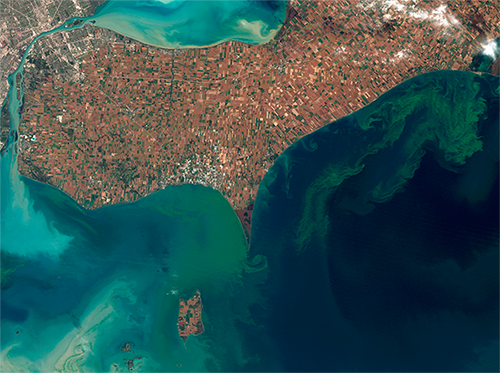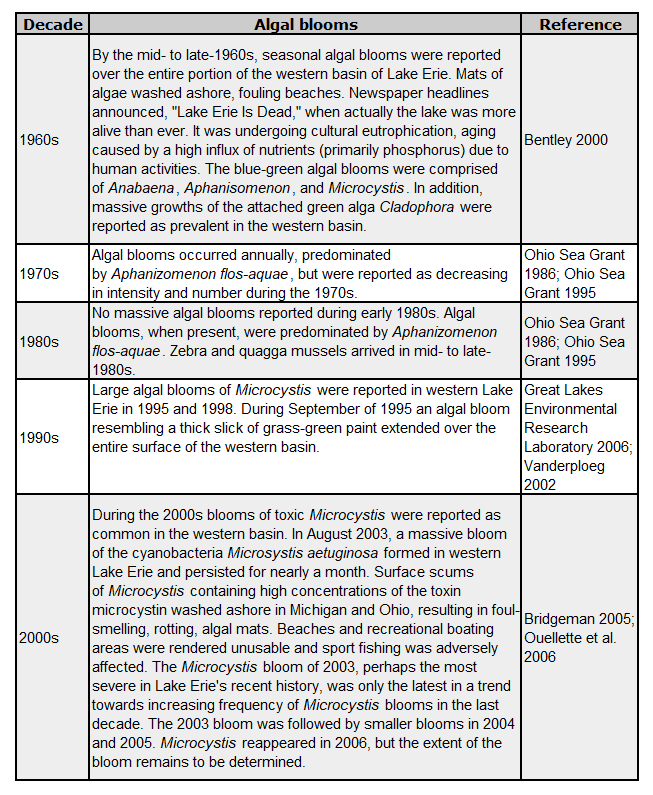Detroit River-Western Lake Erie Basin Indicator Project
Algal Blooms in Western Lake Erie
Background
Since the 1960s scientists have recognized that Lake Erie was undergoing accelerated or cultural eutrophication (Beeton 1961). Eutrophication is a natural aging process of lakes, but it can be accelerated by human activities. Cultural eutrophication refers to the accelerated aging of a lake caused by elevated nutrient loadings (primarily phosphorus in freshwater systems) from human activities.
Concurrently during the 1960s, the public at large recognized that Lake Erie was highly eutrophic, as evidenced by:
- algal blooms covering large areas of the lake during summer months;
- attached green algae, called Cladophora covered most rocky and human-made structures;
- decomposing algae, that were washing up on bathing beaches, had to be removed by bulldozers;
- blue-green algae were causing taste and odor problems in some municipal water supplies; and
- dissolved oxygen was being depleted (used up by decomposing algae) from many of the deeper areas of the lake.
Status and Trends
In response to algal blooms in Lake Erie during the 1960s (Table 1), the U.S. and Canada signed the 1972 Great Lakes Water Quality Agreement that led to a coordinated effort to reduce phosphorus inputs to the Great Lakes, including Lake Erie. Between the late 1960s and early 1980s there was an approximate 60% reduction in phosphorus loading to Lake Erie. Lake Erie responded with reduced phosphorus concentrations (Panek et al. 2003). Lower phosphorus concentrations reduced the amount of algae (Nicholls et al. 1977), including an 89% decline of the blue-green alga Aphanizomenon flos-aquae between 1970 and 1983-1985 (Makarawicz and Bertram 1991).
Zebra mussels arrived in the Great Lakes in the mid-to late-1980s. The mussels are filter feeders capable of removing much of the planktonic algae (phytoplankton) from the water. Colonization of Lake Erie by zebra mussels resulted in several years of improved water clarity and dramatic food web changes, especially a shift in algal production from phytoplankton to bottom-dwelling algae and plants.
In the 1990s, however, large late-summer algal blooms began to reappear in western Lake Erie. Blooms occurred sporadically in the late 1990s, but seem to be increasing in frequency since at least 1992 (Table 1). Summers of 2003-2006 all had blooms of varying magnitude. These blooms have been dominated by the blue-green alga (cyanobacteria) Microcystis aeruginosa (Figure 1). Microcystis had been a common species in Lake Erie for at least a century, but rarely grew to nuisance bloom proportions. Blooms of Microcystis become most evident during calm periods when the cells float to the surface and form a scum. Continually windy weather may prevent the formation of surface scums, but the overall biomass of algae in the water may still be high (as in 2005).

Figure 1. Microcystis aeruginosa bloom in western Lake Erie during 2011 (photo credit: NASA).
Blooms of Microcystis are of concern because Microcystis is poor food for the tiny grazing crustaceans (zooplankton) that are, in turn, important food for larval fish. Microcystis also often contains a potent toxin called microcystin that when ingested by animals may damage the liver. Since most municipalities along the lakeshore obtain drinking water from Lake Erie, this is of special concern. It is believed that water treatment procedures are effective in removing the toxin and to date there have been no reports of the toxin in drinking water supplies.
It appears from several research studies that recent algal blooms in western Lake Erie are linked to nutrient loading, nutrient releases by zebra mussels, and selective feeding by zebra mussels, but much more work needs to be done. Research performed by Great Lakes Environmental Research Laboratory (GLERL) and partners has provided hypotheses and some answers to explain the zebra mussel-Microcystis connection.
Experiments at GLERL with water from Saginaw Bay and Lake Erie have shown that zebra mussels selectively filter and reject phytoplankton so as to promote and maintain Microcystis blooms (Vanderploeg 2002). Using special video equipment, GLERL showed that mussels filter the water whether or not Microcystis is present, but they spit Microcystis back into the water, while at the same time they eat other algae. Thus, the competitors of Microcystis are removed. This probably explains why Microcystis has been a dominant alga in many summers. At the same time this selective feeding process is occurring, the mussels are excreting nutrients (phosphate and ammonia) derived from the phytoplankton they eat as part of digestion and metabolic processes. These nutrients, in turn, serve to fertilize further growth of Microcystis.
Table 1. A summary of the history of algal blooms in western Lake Erie.


Management Next Steps
Canadian and United States Governments have supported a "hold the line on phosphorus levels" position to help prevent further deterioration of Lake Erie. In addition, much more effort must be expended on preventing exotic species, like zebra and quagga mussels, from entering the Great Lakes.
Currently, there is much uncertainty as a result of insufficient knowledge of how the Lake Erie ecosystem is functioning and the factors and processes driving the ecosystem. The major, poorly understood changes in Lake Erie have taught us that management programs, research, and monitoring must be sustained and closely coupled in order to achieve our goals for Lake Erie. In addition, some managers have recommended that we explore development of management strategies to adapt to these invaders like zebra mussels, which are now a permanent part of the Great Lakes ecosystem.
Research/Monitoring Needs
Much greater emphasis needs to be placed on detection, characterization, and prediction of harmful algal blooms. In addition, research is warranted on evaluating increasing nutrient loadings resulting from changes in land-use practices, altered hydrology, and further food web changes.
Prediction of outcomes through modeling is essential for adaptive management. Modeling is needed to better predict:
- upper food web predator-prey interactions, population dynamics and coupling with lower food web;
- determination of organic carbon flow pathways through the microbial food chain, benthic primary and secondary production, and coupling with pelagic food web;
- zebra and quagga mussel population dynamics and processing of nutrients; and
- the impact of fine-scale physical processes on ecosystem-level biological interactions in Lake Erie.
Microcystis is known to produce toxins called "microcystins" that have been responsible for some bird and fish kills. Further research is warranted into what triggers Microcystis to produce the toxins, for they are not in production all the time.
References
- Beeton, A.M. 1961. Environmental changes in Lake Erie. Transactions of the American Fisheries Society 90:153-159.
- Bentley, L. 2000. Envirnomental Education for Ohio, Biosphere 2000 Project, Environmental Science in Action: Lake Erie. (August 2006).
- Bridgeman, T. 2005. University of Toledo Lake Erie Center - Water Quality Monitoring in Western Lake Erie and Maumee Bay. (August 2006).
- Great Lakes Environmental Research Laboratory (GLERL). 2006. The Role of Zebra Mussels in Promoting Microcystis Blooms and Other Ecosystem Changes in Saginaw Bay and in Lake Erie. (August 2006).
- Makarawicz, J.C. and P. Bertram. 1991. Evidence for the restoration of the Lake Erie ecosystem. Bioscience 41(4): 216-223.
- Nicholls, K.H., D.W. Standen, G.J. Hopkins, and E.C. Carney. 1977. Declines in the nearshore phytoplankton of Lake Erie's western basin since 1971. Journal of Great Lakes Research 3: 72-78.
- Ohio Sea Grant. 1986. "Lake Erie water quality, 1970s to mid-1980s" PDF (August 2006).
- Ohio Sea Grant. 1995. Thick Slick of Green Ick: Bloom of Blue Green Algae Returns to Lake Erie. (August 2006).
- Ouellette, A.J., Handy, and S.W. Wilhelm. 2006. Toxic Microcystis is widespread in Lake Erie: PCR detection of toxin genes and molecular characterization of associated cyanobacterial communities. Microbial Ecology 51(2): 154-165. (August 2006).
- Panek, J., D.M. Dolan, and J.H. Hartig. 2003. Detroit's role in reversing cultural eutrophication of Lake Eire. In Honoring Our Detroit River, Caring for Our Home, Ed. J.H. Hartig, Cranbrook Institute for Science, Bloomfield Hills, Michigan. pp. 79-90.
- Vanderploeg, H. 2002. The Zebra Mussel Connection: Nuisance Algal Blooms, Lake Erie Anoxia, and other Water Quality Problems of the Great Lakes. National Oceanic and Atmospheric Administration, Great Lakes Environmental Research Laboratory. (August 2006).